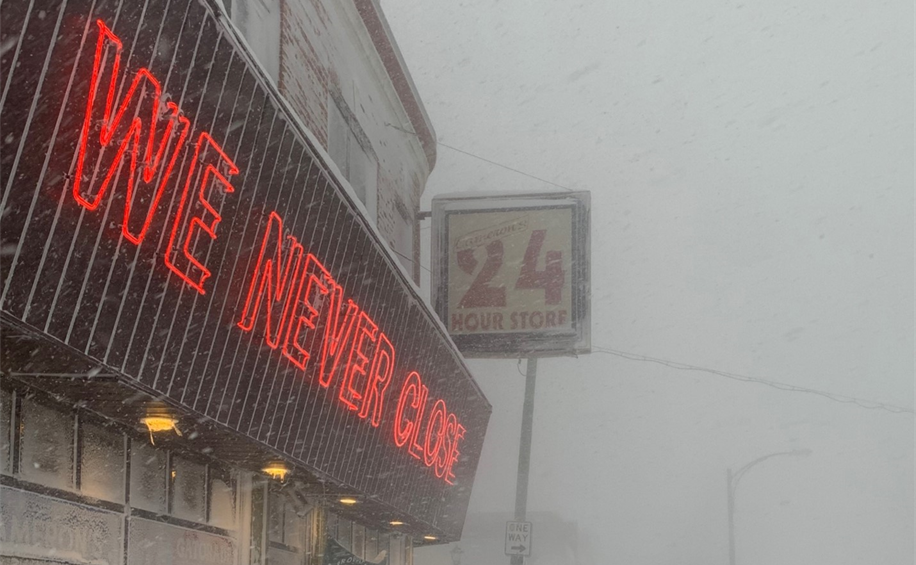I was 1 year old when the legendary blizzard of ’77 struck Buffalo, NY.
This coincidence made me a “blizzard baby,” as my late mother Gail frequently recalled with a fond, nostalgic smile. She shared the Buffalo folklore tales of snowbanks towering to the height of telephone poles. Kids sledded down from second-floor windows of their houses.
Buffalo Stereotypes
The national mainstream media constructs a stereotype that Buffalo receives the most snow of anywhere in the region. Syracuse, located in central New York, experiences more annual snowfall. The suburbs south of Buffalo are typically hit the hardest with lake effect snow, not the city. These nuances in geography in upstate New York matter.
The national television images of Buffalo Bills football players making snow angels on the field following a game several years ago playfully reproduces the stereotype that Buffalo operates in a state of perpetual snowstorms.
As a kid I played the Blizzard of ’77 board game with my older sister Jennifer. Part of the game is that you have to collect provisions such as a shovel from the hardware store and groceries to prepare for an impending storm. As a particular card is drawn, the blizzard strikes and the board is flipped over to storm mode. The goal is to make it home safely.
Local News
On my latest trip I was visiting my family and friends in the Buffalo area for the December holidays. I currently live in the Pacific Northwest, where a couple of inches of snow can close schools for the day — quite amusing for a Western New Yorker.
The local Buffalo broadcast news offered stark predictions that this would be the storm of a lifetime. The impact would devastate the city as an impending bomb cyclone. One anchor proclaimed, “we’re not trying to scare you.” I wasn’t the only one who downplayed this ominous news. Western New Yorkers are inured to extreme winter weather reports. In our region, snow is simply part of life, like chicken wings, Canadian beer, and football.
Local broadcast news outlets profit economically from sensational information. They operate as a business. As a media professor I was skeptical of the news and warnings they provided. As the storm arrived, I could not have been more wrong.
Anxieties and Stocking Up
Two hours before the storm unfurled, I dropped off my friends at the Buffalo Niagara International airport. I was house- and dog-sitting for them.
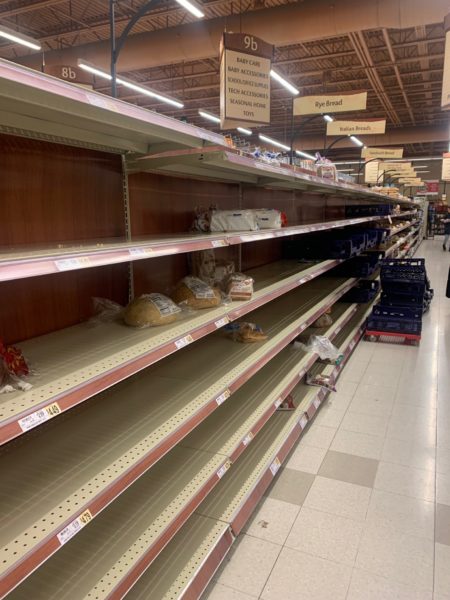
Bread isle of Wegman’s grocery store in Buffalo, NY. Smartphone Photo by David Gracon
I briefly stopped at the local supermarket, Wegmans, to stock up on food, enacting what the Blizzard of ’77 boardgame promoted. A quiet panic seemed to ripple through the shoppers. The bread aisle was completely ransacked. No milk or eggs remained. Anxiety filled the air as the long checkout line stretched around the corner and out of sight. This massive store had only one cashier working. Outside, the wind blew ominously.
Back at my friend’s house in the city, the snow started to fall, a light flurry at first. Eventually, I couldn’t see the houses across the street. The storm rapidly transformed into a whiteout blizzard. It tipped giant garbage cans over, their contents sprawled out into the street. Branches fell to the ground. The streets were abandoned, emptied of humans. The trees swayed viciously.
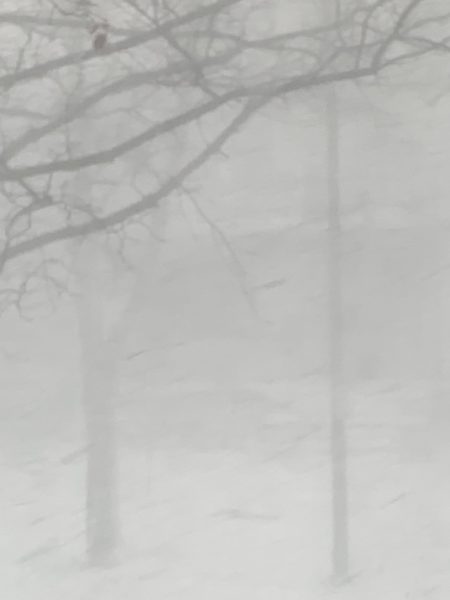
Looking outside of the house in Buffalo, NY. Whiteout snow conditions. Smartphone Photo by David Gracon
Losing Power
My nephew told me residents in the suburbs had lost power, but it was already restored. This news infused me with me a false sense of relief about my own circumstances in the city of Buffalo.
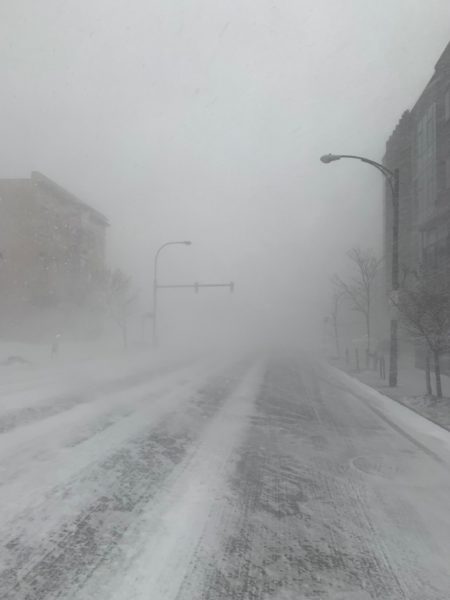
Elmwood Avenue. Buffalo, NY. Smartphone Photo by David Gracon
Within hours, the power and heat went out in the Buffalo neighborhood where I was staying. It was out of service for three days.
The temperature in the house dropped to 32 degrees inside. I could see my breath. The water inside the toilet bowl froze. The house shook from the unrelenting, pounding wind. An upstairs window blew open and an inch of snow covered the kitchen floor of that unit. I smelled a gas leak. It was untenable to stay. Luckily, Larry, the dog I was watching, and I took refuge with friends nearby who didn’t lose power and coincidentally happened to be in town. I was very fortunate.
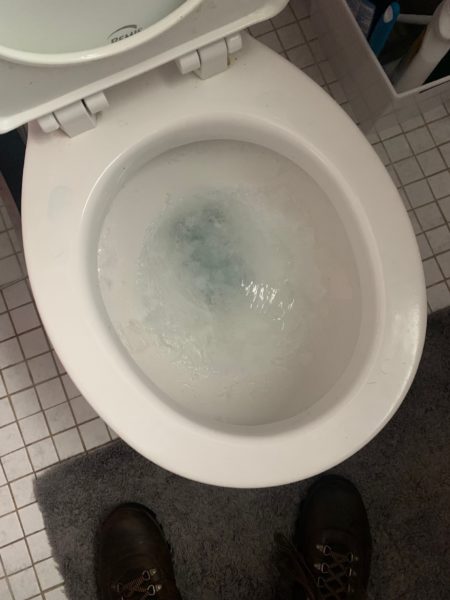
Frozen toilet bowl. Buffalo, NY. Smartphone Photo by David Gracon
This abrupt confinement summoned up the lingering COVID-19 pandemic lockdown trauma.
Almost all the businesses in the city were closed. Mobility was extremely limited. The streets were empty in a surreal way with a driving ban in effect. Completely buried in snow, cars looked like giant eggs. One lone person haphazardly drove by with their head out the window, dangerously attempting to navigate the street while driving.
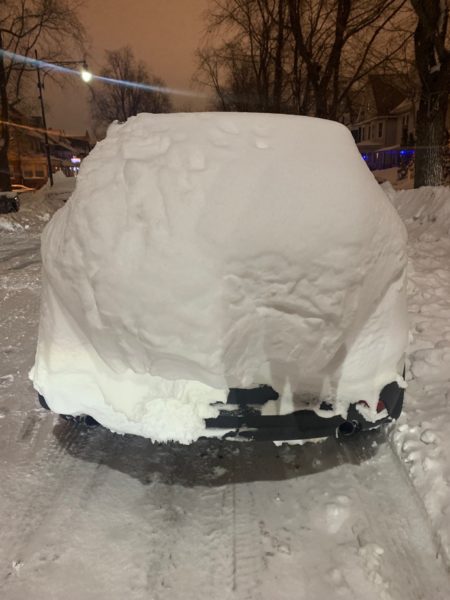
Car covered in snow, Buffalo, NY. Smartphone Photo by David Gracon
As their vehicles were getting stuck in the snow, police and ambulances could not get to you in an emergency. No emergency services could rescue anyone, except in rare cases by snowmobile. I have never experienced anything on this order of collapse. I was terrified.
Unplowed
The snow came up to my knees on the main streets. Walking was difficult in snow drifts as high as four feet. I have never in my life seen main city streets completely unplowed. At least a foot of snow covered Elmwood Avenue, Buffalo’s bohemian drag. Larry, unable to walk properly, pranced like a reindeer navigating the sidewalks as his black fur coat became covered in snow. Because the plows were getting stuck, it was dangerous to complete the plowing. The city’s snow removal gear was in disrepair and outmoded.
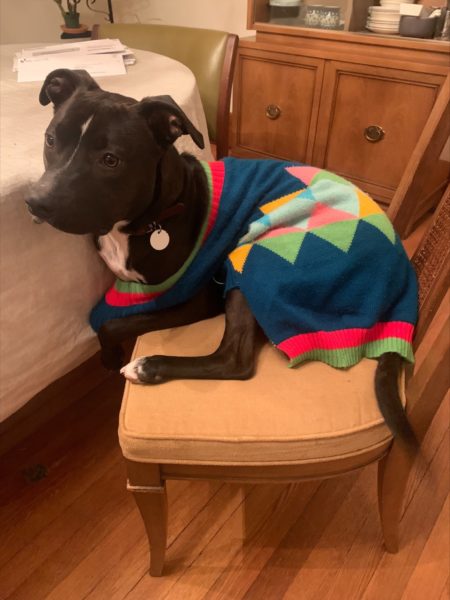
Dog sitting with Larry. Smartphone Photo by David Gracon
I ventured out with my friends Scott and Sarah, whom I was now crashing with, on cross-country skis. With the ferocity of 70 mph hurricane winds, the blistering snow pelted my face. Because the wind and snow hurt my eyes, I had to turn my gaze toward the ground. Sarah wore ski goggles. If my face wasn’t properly tightly wrapped with a scarf, I would have gotten frostbite.
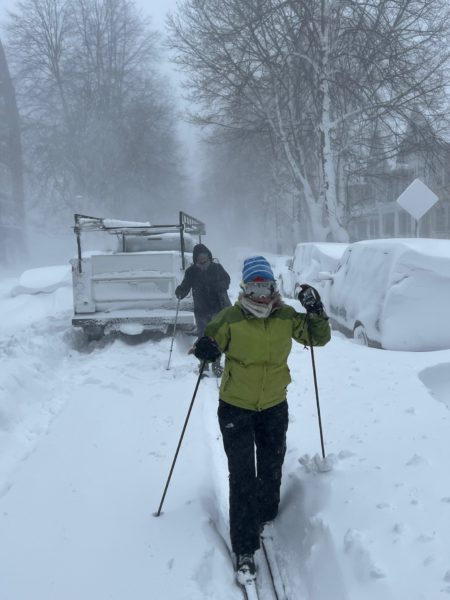
David and Sarah get around by cross country skis. Utility truck stuck in the middle of the road. Smartphone Photo by Scott Gable.
Disparage all you want about the Metaverse, but the Buffalo Blizzard 2022 Facebook group fostered tremendous community support and remarkable solidarity. Complete strangers checked in on Sarah’s sickly elderly relative who was living alone and wasn’t responding to phone calls. Luckily, he was found alive by someone who happened to live around the corner — a speedy reply to her emergency Facebook post. Civilians on snowmobiles rescued people trapped in cars and saved lives because of this social media page.
One man broke into a primary school and temporally housed a group of 25 stranded people. He left the school a handwritten thank you note. He was gifted Super Bowl tickets by a former Buffalo Bill’s player who recognized him as a hero. Hummers from the National Guard patrolled the city and transported nurses to their hospital shifts. Hulking energy utility vehicles with plates from as far away as Texas and Florida dotted the city.
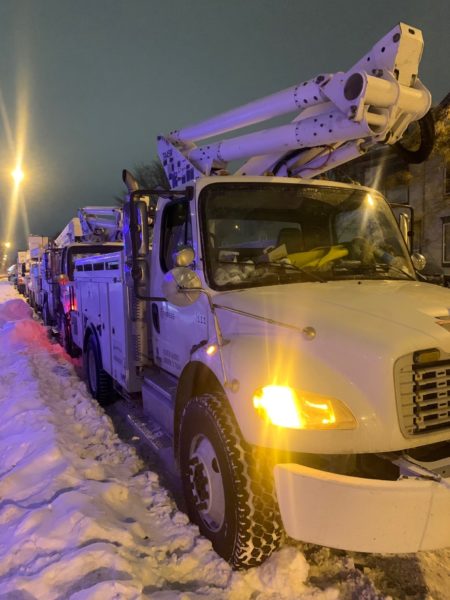
Energy utility trucks with plates from Texas and Florida. Buffalo, NY. Smartphone Photo by David Gracon
Although the storm hit the southern suburbs, it was much more intense in the city of Buffalo itself. When I spoke with family in Hamburg in the southtowns, it felt they were living through a completely different reality. Their roads were being plowed with modern machinery and human resources far beyond those in the city of Buffalo. This area has less population density and fewer people are forced to park on the streets, thus making plowing much less complicated. The driving ban lifted several days before it did in the city. This area was privileged: they had mobility. Life returned to normal faster in the suburbs.
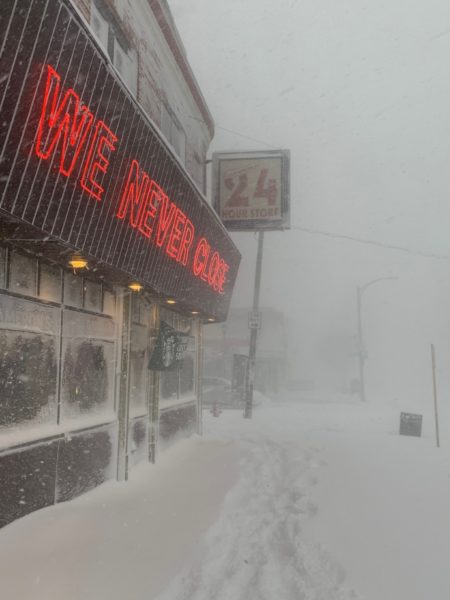
Cameron’s 24 Hour Store. Commonly referred to as We Never Close. Buffalo, NY. Smartphone Photo by David Gracon
In contrast, people in the city of Buffalo died in the freezing cold and snow. They perished attempting to buy milk walking to a corner grocery store. Frozen corpses were discovered in snowbanks and inside stranded cars.
As I write this, 47 people have been confirmed dead from the winter storm, and half of the dead are African American. The storm’s ferocious mixture of apocalyptic weather and gross economic and racial inequalities plaguing the city for generations can be witnessed in these statistics. This scenario is unjust.
The city is simultaneously reeling from the vicious mass murder of ten African Americans by a white supremacist in a Tops Supermarket on the east side last May. The historical, racial, and economic traumas layered, and further compounded by this abrasive winter storm.
Fluctuating Weather and News Cycles
Days later, fluctuating weather patterns produced a radical jump cut. Rain began to melt the snow, resulting in puddles with gasoline rainbows and bleak snowbanks outlined by mud and dirt. The storm was declared a national emergency by President Biden.
As the city reeled from the storm, people gathered in local bars to watch football to try to resurrect some semblance of normalcy.
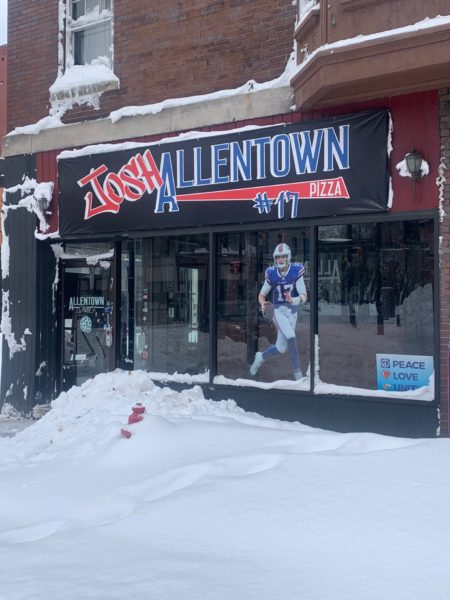
Josh Allentown Pizza on Elmwood, Avenue. Buffalo, NY. Smartphone Photo by David Gracon
On live national television, the Buffalo Bills player Damar Hamlin tragically suffered a cardiac arrest on the field and nearly died, a media spectacle reminiscent of a Black Mirror episode when juxtaposed with glossy TV advertising breaks. Another trauma hits Buffalo, just days after the storm. Corporate mainstream media covered Damar’s remarkable recovery in great detail. Yet the news of 47 everyday citizens who died during the winter storm in Buffalo evaporated from any meaningful coverage or critical analysis.
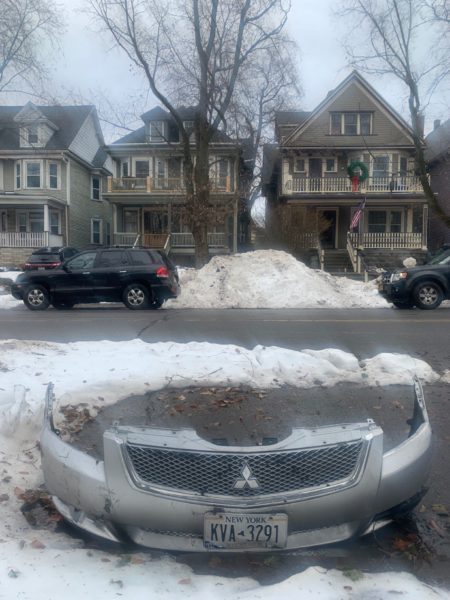
Melting snow after the storm. Buffalo, NY. Smartphone Photo by David Gracon
The news cycle churns on, spewing out new content while those who experienced the most devastating winter storm ever to hit Buffalo grapple with trauma, loss, and anger over how local officials mishandled storm preparations.
For example, local government could have instituted the driving ban earlier. That would have prevented people from going to work, getting stuck or stranded, or possibly perishing in the snow. Because it was the busy and profitable Christmas shopping season, workers, especially those living paycheck to paycheck, were forced to work and brave the storm in order to survive and pay their bills. This strikes me as another case of deeply gross injustice.
Catastrophes and Traumas
As new storms pummel California and Alabama, coverage of the Buffalo blizzard has largely disappeared from the national media consciousness. Due to global climate disruptions, more storms are coming. Media representations will come and go, ephemeral digital ghosts camouflaging continuing traumas. Corporate media maximizes profits, providing scant historical or political context for these catastrophes, churning on to the next story.
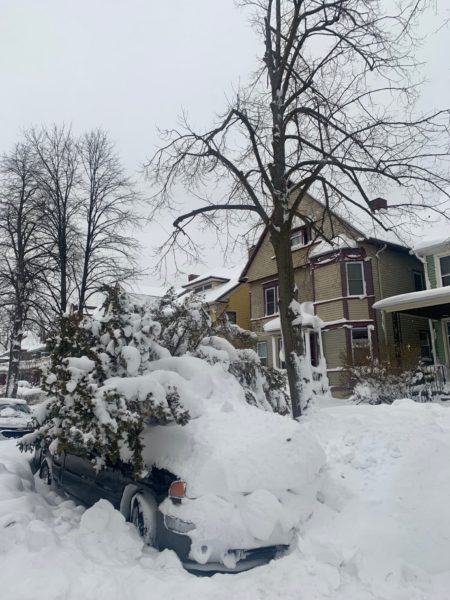
Fallen tree on top of a truck. Buffalo, NY. Smartphone Photo by David Gracon
Open the latest social media app. There are new shows waiting be streamed. We are awash in media. I am no longer sure what it all means other than chaos, and anomie. Yet, as the example of the Buffalo Storm Facebook group exemplifies, instances of hope, solidarity, and collaboration enhanced by a variety of media platforms also exist.
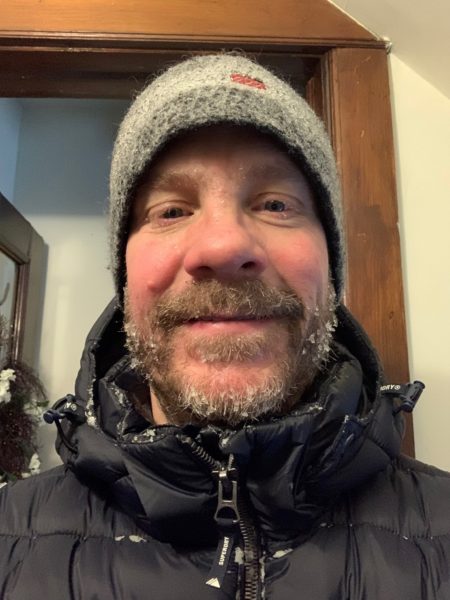
Storm Selfie of David Gracon. Smpartphone Photo by David Gracon
Like many in Buffalo I struggle to make sense of what happened during this once in a lifetime blizzard after the mainstream media images fade away. This storm turned out to be more catastrophic and dangerous than the famous blizzard of ’77. The deadly magnitude of this winter storm was beyond anyone’s comprehension or previous reference point.
I live with the aftermath of this historic storm, working through the multiple traumas. This blizzard baby is lucky — and very privileged — to be alive.
David Gracon is an assistant professor of Integrated Media at Gonzaga University located in Spokane, Washington. His research/teaching interests include media literacy, alternative media, and the political economy of communication. His film/video works have screened at the Chicago Underground Film Festival, and over fifty others. In 2017/2018 he was a U.S. Fulbright Scholar teaching media studies at Precarpathian National University in Ivano-Frankivsk, Ukraine. He received his doctorate in media studies from the University of Oregon in 2010. He grew up in Hamburg, NY and earned his MA in the Department of Media Study/Sociology at SUNY Buffalo.

